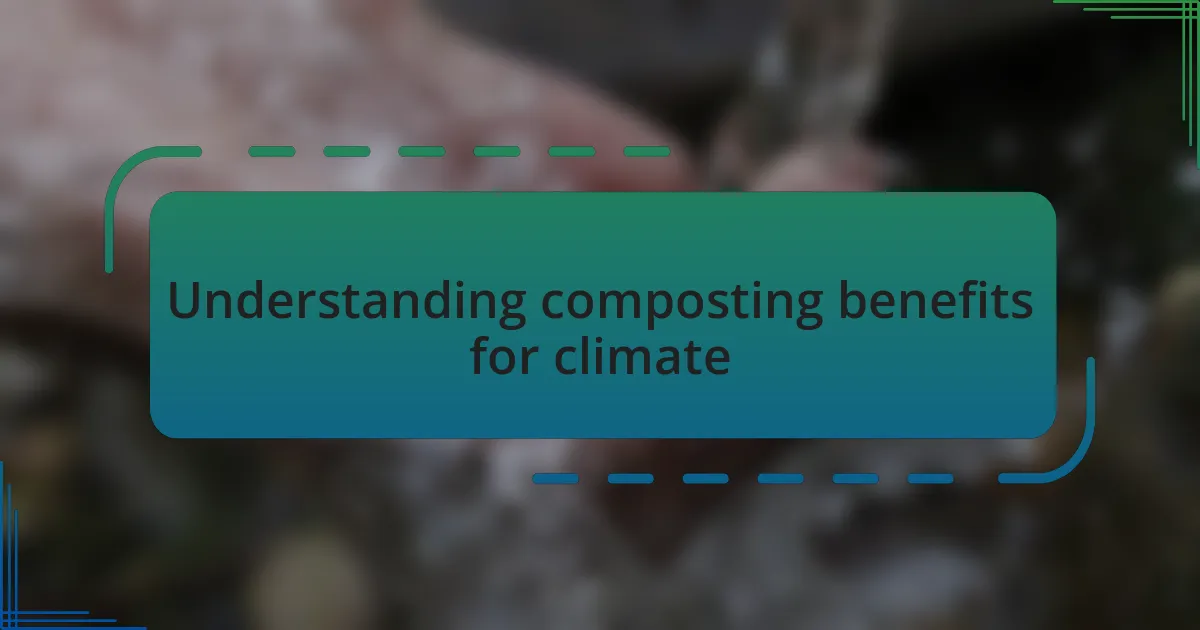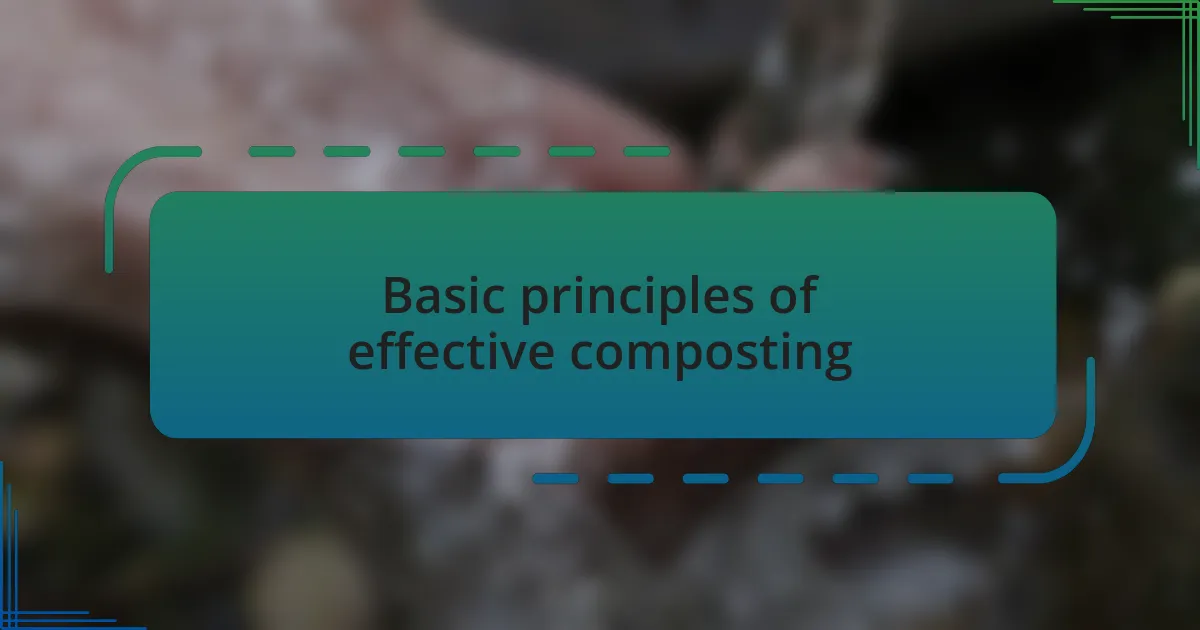Key takeaways:
- Composting reduces methane emissions from landfills, helping mitigate climate change while enriching soil and enhancing carbon sequestration.
- Key principles of effective composting include maintaining a balance of green and brown materials, ensuring proper aeration, and controlling moisture levels.
- Layering compost materials and adding kitchen scraps gradually improves aeration and moisture retention, enhancing decomposition.
- Troubleshooting composting issues like odors and pests often involves adjusting moisture levels, aeration, and maintaining a regular composting routine.

Understanding composting benefits for climate
Composting offers remarkable benefits for our climate that often go overlooked. When I first started composting my kitchen scraps, I was amazed to learn that reducing organic waste can significantly cut down methane emissions from landfills. Did you know that methane is a greenhouse gas with a warming potential 25 times greater than carbon dioxide? Just reflecting on my backyard compost pile is a reminder of how something as simple as food scraps can mitigate climate change.
Furthermore, compost enriches the soil, enhancing its ability to sequester carbon. I remember the first time I used my homemade compost while gardening—the transformation in my plants was stunning. It wasn’t just about growing healthier vegetables; it became a direct way for me to give back to the Earth. Isn’t it empowering to think that, through composting, one can contribute to carbon capture and improve food security?
On a broader scale, if more people adopted composting, we could make a collective difference in our carbon footprint. It makes me wonder: what if everyone took this small step in their homes? While my composting journey began on a personal level, I can see it spiraling into a larger movement that fosters community resilience and sustainability. Reducing waste while enriching our planet feels like a win-win for all of us.

Basic principles of effective composting
Effective composting hinges on a few basic principles that ensure a successful and efficient process. To start, maintaining the right balance of green and brown materials is crucial. I remember my first attempt, where I tossed in a mountain of vegetable scraps but forgot about the dry leaves and cardboard. It wasn’t until I learned about this balance that my compost began to heat up and break down efficiently.
Another key principle is aeration, which facilitates the breakdown of organic matter. I often find myself turning my compost pile every week, and it not only speeds up decomposition but also gives me a moment to connect with my compost. Have you ever taken a deep breath and felt the earthy aroma wafting up? It’s like the smell of nature’s magic working right in your backyard.
Lastly, moisture control is vital for effective composting. Too little moisture can slow down the decomposition process, while too much can lead to a smelly, anaerobic pile. In my experience, when my compost feels just like a wrung-out sponge, it’s in the sweet spot for thriving microbes to do their job. So, how does your own compost stack up? Are you ready to dig in and tinker with these principles for a more effective composting adventure?

Personal composting techniques that succeed
One technique that has consistently worked for me is layering my compost materials. I tend to create alternating layers of greens and browns, which not only improves aeration but also helps with moisture retention. I recall a time when I wanted to speed up the process—so I decided to throw in a whole bunch of fresh grass clippings without any browns. The result was a slimy mess! Since then, I’ve learned that thoughtful layering can make a world of difference.
I also swear by the practice of adding in small amounts of kitchen scraps gradually, rather than one big batch. It feels more manageable, and it allows me to monitor how my compost interacts with each new addition. When I toss in my coffee grounds or eggshells, I get a little thrill, knowing I’m feeding not just the compost but also the soil that will nourish my plants later. Have you tried adding your scraps in smaller doses, and noticed a difference in your compost’s texture and smell?
Another technique that brings me joy is using a compost thermometer. Monitoring the internal temperature of my compost pile is not just functional; it’s exciting! I remember the first time I saw the needle rise into the hot zone of 130-150 degrees Fahrenheit. It felt like I was nurturing a living system. This gadget keeps me informed about whether my compost is healthy and active, prompting me to make adjustments when necessary. Do you find it rewarding to track the progress of your compost? I certainly do!

Troubleshooting common composting issues
When my compost started to emit a foul odor, I was taken aback because I thought I was doing everything right. After some investigation, I realized it was too wet and lacked sufficient airflow. I turned it over enthusiastically, added some dry leaves, and just like that, the bad smell faded. Have you experienced that panic moment, only to find a simple fix made all the difference?
Another issue I faced was finding insects buzzing around my compost pile. At first, I saw them as a nuisance; however, I learned they are often a sign of healthy decomposition. I started to focus on keeping my compost well-aerated and balanced—this helped encourage beneficial organisms while keeping the pesky flies at bay. Have you noticed the role that these bugs play in your compost’s health?
One time, I neglected my composting routine for a few weeks and came back to find it all but frozen in time. It was a reminder of how important consistent management is. I learned that simply rotating it more regularly and maintaining a proper mix of ingredients keeps the pile active and vibrant. Do you maintain a routine with your compost, or do you find yourself forgetting about it sometimes?